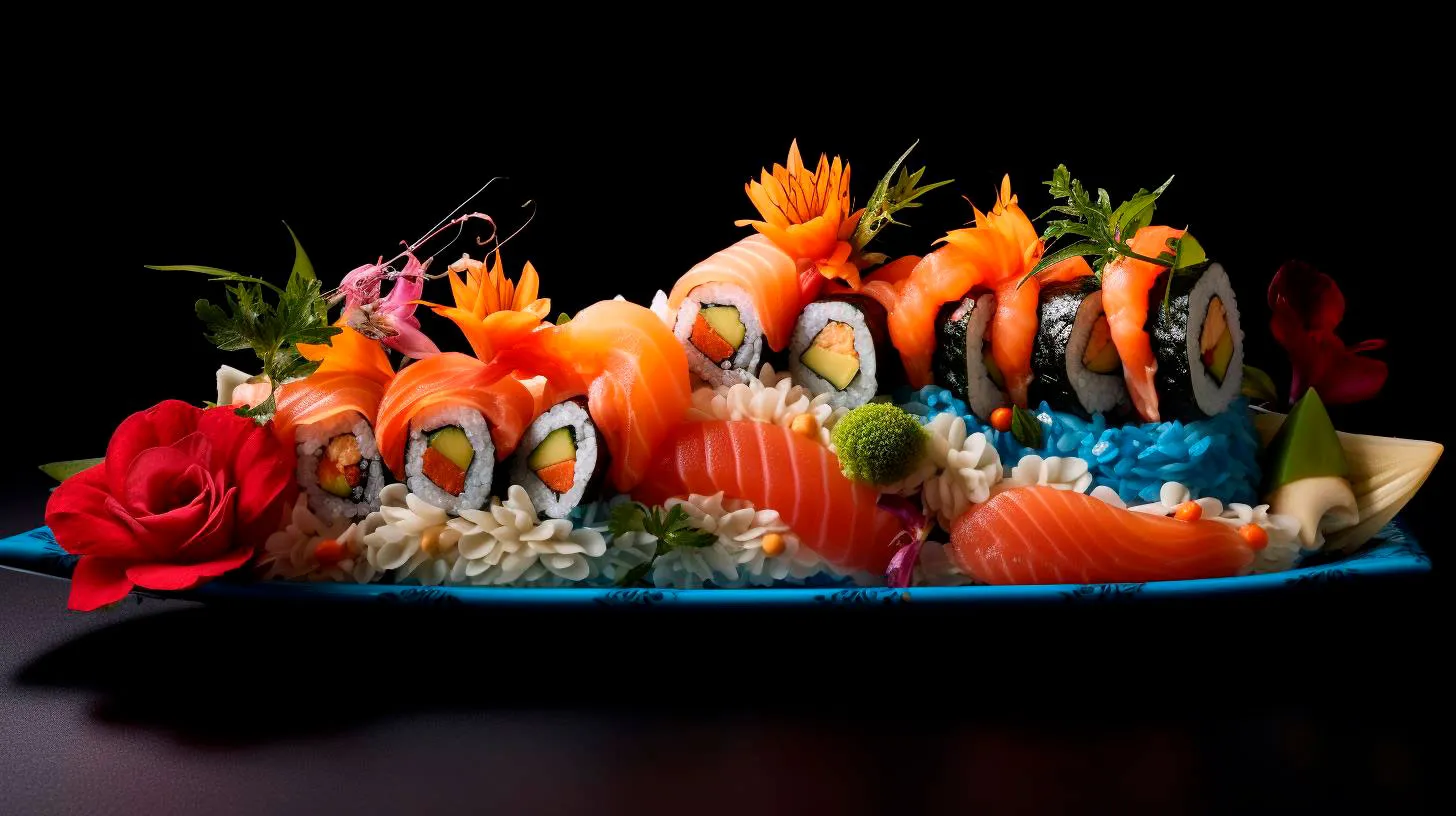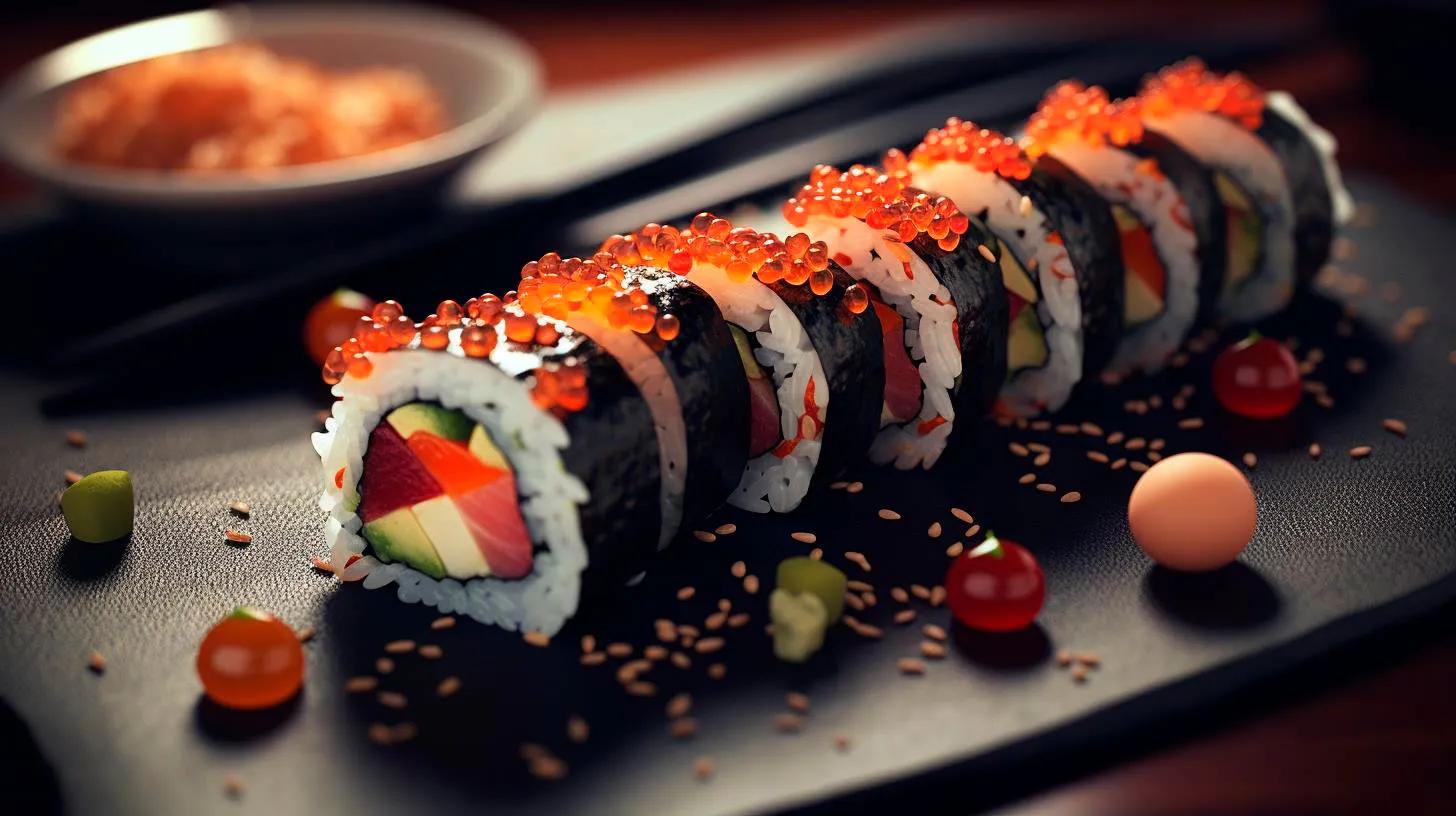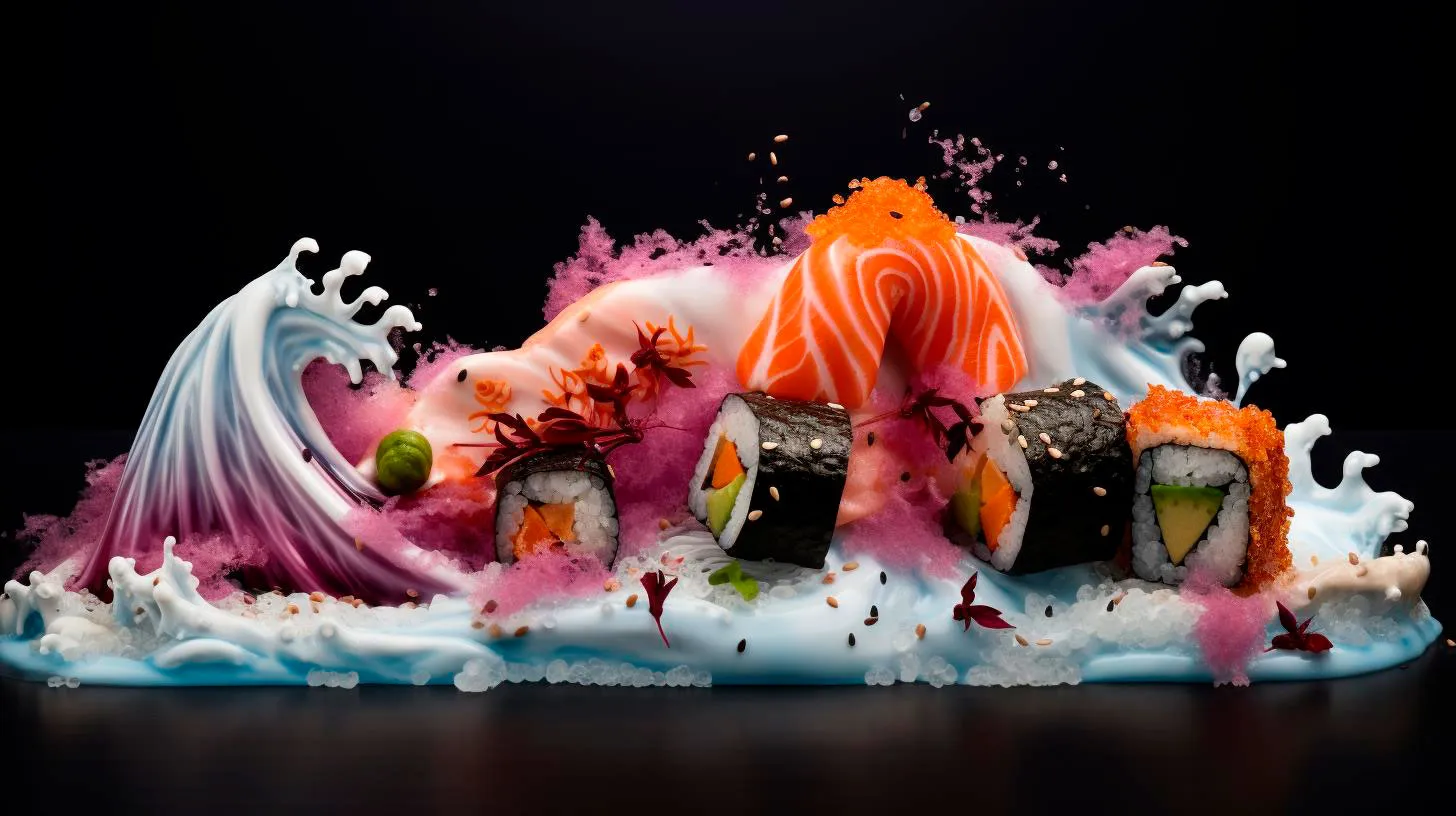Savoring the Legacy of Sushi: An In-Depth Exploration of its Role in Japanese Feasting
A Brief History of Sushi
Sushi traces its origins back to ancient Japan, where it was initially created as a method for preserving fish. Originally, fish was fermented with rice and salt to preserve it for extended periods. Over time, this preservation technique transformed into what we now know as sushi. Today, sushi has evolved into an art form, with various regional styles and an array of fresh ingredients.
Sushi gained worldwide popularity in the 20th century, thanks to advancements in transportation and globalization. Modern sushi has gone through numerous innovations, blending traditional methods and contemporary techniques to create an exciting culinary experience.
The Art of Sushi Making
Preparing sushi is a meticulous craft that requires years of training and expertise. Sushi chefs, known as Itamae, learn the art from experienced mentors, following a strict hierarchy and apprenticeship model. From the selection of top-quality ingredients to the precision in cutting and arranging, every step is crucial to achieving the perfect balance of flavors and textures.
Key Takeaway: The art of sushi making involves extensive training, precision, and attention to detail.
Types of Sushi
Sushi offers a diverse range of flavors, textures, and presentations. Here are some popular types of sushi:
- Nigiri: Consists of a slice of raw fish or seafood placed on vinegared rice.
- Maki: Rolled sushi, using a bamboo mat, filled with rice, fish, and vegetables wrapped in seaweed.
- Sashimi: Thin slices of fresh raw fish served without rice.
- Temaki: Hand-rolled sushi, resembling a cone, filled with various ingredients.
Key Takeaway: Sushi offers a variety of types, each with its own distinctive taste and presentation.
The Role of Sushi in Japanese Feasting
Sushi holds cultural significance in Japan and plays a central role in traditional feasting. It is not just a meal but a sensory experience that embodies respect for nature, tradition, and meticulous craftsmanship. Here are some key aspects worth savoring:
1. Ritual and Tradition:
Sushi is deeply rooted in Japanese culture and customs. Its consumption is often accompanied by specific rituals, such as the proper way to hold chopsticks or dipping the sushi in soy sauce and wasabi. The process of ordering, serving, and eating sushi follows a traditional etiquette that enhances the dining experience.
2. Umami Explosion:
Sushi brings together a unique blend of flavors that excite the taste buds. From the freshness of the fish and seafood to the slightly tangy rice seasoned with vinegar, each bite is an orchestra of umami, the coveted fifth taste. This explosion of flavors is carefully balanced, providing a delightful culinary adventure.
3. Health Benefits:
Sushi is not only a delightful treat for the senses but also offers numerous health benefits. The use of fresh fish provides an excellent source of omega-3 fatty acids, essential for heart health. Additionally, sushi often incorporates vegetables, boosting the intake of essential vitamins and minerals.
4. Social Bonding:
In Japan, sharing sushi is more than just a meal; it is an opportunity for social bonding and strengthening relationships. The act of sitting together, passing plates, and engaging in conversation cultivates a sense of community and camaraderie.
Key Takeaway: Sushi combines ritual, unique flavors, health benefits, and social bonding, creating a holistic dining experience.
Conclusion
Sushi’s legacy as a beloved Japanese dish is a testament to its cultural significance and gastronomic excellence. From its humble beginnings as a preservation method to its transformation into an art form, sushi embodies the essence of Japanese feasting. Its meticulous preparation, diverse types, and multifaceted role make sushi an unforgettable experience that captivates both locals and travelers alike.
So, the next time you indulge in a plate of sushi, take a moment to appreciate the centuries-old tradition, the balance of flavors, and the dedication of the chefs who’ve perfected this culinary treasure.
Preserving the Cultural Heritage: Tracing the Evolution of Sushi in Japanese Holiday Traditions
In this article, we will take a deep dive into the evolution of sushi in Japanese holiday traditions and explore its significance in preserving the country’s cultural heritage.
The Origins of Sushi
Sushi, derived from the Japanese word “sushi-meshi,” meaning vinegar-flavored rice, traces its roots back to the 8th century. It originated as a method of preserving fish by fermenting it with salt and rice. Over time, this preservation technique evolved into a delectable dish that delighted the palates of the Japanese people.
Initially, sushi was enjoyed as street food, popular among working-class individuals. However, it eventually gained popularity among the aristocracy and samurai classes, leading to various sushi-making techniques and styles. Today, sushi is considered a delicacy enjoyed by people from all walks of life, both in Japan and across the globe.
Sushi in Japanese Holiday Traditions
Japanese holidays are steeped in tradition, and sushi plays an integral role in many of these celebrations. Let’s explore some of the most significant holidays where sushi takes center stage:
New Year’s Day (Oshogatsu)
Oshogatsu, the Japanese New Year, is a time when families come together to celebrate the beginning of a new year. A traditional New Year’s feast called “osechi-ryori” is prepared, consisting of various dishes offered to deities as a sign of gratitude. Sushi, often in the form of “osechi sushi,” is an essential part of this feast. Osechi sushi is beautifully presented and arranged in special lacquer boxes, known as “jubako.”
Girl’s Day (Hinamatsuri)
Hinamatsuri, also known as Girl’s Day, is celebrated on March 3rd to pray for the health and happiness of young girls in the family. Alongside dolls and other symbolic decorations, sushi is prepared to mark this special occasion. A popular sushi variation during Hinamatsuri is “chirashizushi,” which consists of vinegared rice topped with colorful ingredients such as cooked shrimp, shredded omelet, and pickled vegetables.
Boy’s Day (Children’s Day, Kodomo no Hi)
Kodomo no Hi, also referred to as Boy’s Day or Children’s Day, is celebrated on May 5th to celebrate the happiness and success of boys in the family. The traditional dish associated with this day is “kashiwa-mochi,” a sticky rice cake filled with sweet bean paste wrapped in an oak leaf. However, sushi also finds its way onto the table, symbolizing good luck and prosperity for the children.
The Significance of Sushi in Preserving Cultural Heritage
Sushi’s enduring presence in Japanese holiday traditions holds great cultural significance. Here are some key takeaways that reflect the importance of sushi in preserving Japan’s cultural heritage:
- Celebration of Tradition: By including sushi in holiday feasts, Japanese people pay homage to their ancestors and keep ancient traditions alive.
- Symbolism: Each sushi variation holds symbolic meaning, representing good fortune, prosperity, and the happiness of family members.
- Connection to Nature: Sushi ingredients often reflect seasonal changes and promote a deeper connection with the natural world.
- Passing Down through Generations: Teaching the art of sushi-making from one generation to the next ensures the preservation of traditional culinary practices.
- Global Recognition: Sushi’s worldwide popularity has led to a greater appreciation and understanding of Japanese culture beyond traditional borders.
Conclusion
Sushi’s journey from a preservation method to a cherished delicacy is a testament to the enduring traditions and cultural heritage of Japan. By embracing sushi as an integral part of their holiday celebrations, the Japanese people have successfully preserved their customs, ensuring their continuation for generations to come. As you savor the flavors of sushi during these festive occasions, take a moment to appreciate the rich history and cultural significance behind each bite.
Exploring the Origins of Sushi: A Culinary Journey through Japanese Festivities
Ancient Beginnings
The roots of sushi can be traced back to ancient times in Southeast Asia. The concept of preserving fish by fermenting it with rice was initially developed as a way to preserve fish for later consumption. This method proved to be highly effective in preserving food, especially in the absence of refrigeration.
As this preservation technique made its way to Japan, it evolved over time. During the Muromachi period (1336-1573), the Japanese began to eat the rice along with the fish, marking the transition from a preservation method to a culinary delight.
Sushi gained popularity among the common people during the Edo period (1603-1868) when street vendors started selling this delectable treat. These early versions of sushi were simple and consisted of fermented fish wrapped in rice and seaweed.
Sushi Evolution
Over the years, sushi underwent various transformations, each bringing its own unique flavor and style to the table. Let’s explore some significant milestones in the evolution of sushi:
- Nigiri Sushi: In the early 19th century, nigiri sushi was created. This style of sushi involved placing a slice of raw fish on top of a small ball of vinegared rice. Nigiri sushi is often garnished with wasabi and served with soy sauce.
- Maki Sushi: The Edo period also witnessed the rise of maki sushi, which translates to “rolled sushi.” In this style, a bamboo mat is used to tightly roll rice, fish, and vegetables in a sheet of seaweed. Maki sushi is then sliced into bite-sized pieces.
- Chirashi Sushi: Chirashi sushi, meaning “scattered sushi,” became popular during the Edo period. It refers to a bowl of sushi rice topped with various ingredients such as sashimi, vegetables, and pickled items.
Sushi and Japanese Festivities
In Japan, sushi is deeply connected with various traditional festivities and celebrations. Let’s take a closer look at how sushi adds flavor to these occasions:
New Year’s Celebration (Shogatsu)
During New Year’s celebrations, sushi plays a vital role in Japan. Families come together to prepare and enjoy an elaborate feast known as osechi ryori. This special meal features beautifully arranged sushi, symbolizing good luck, happiness, and prosperity for the upcoming year.
Cherry Blossom Festival (Hanami)
As Japan welcomes the arrival of spring, people gather under blooming cherry blossom trees to enjoy picnics and celebrate the beauty of nature. Sushi is a popular choice for these outdoor gatherings, as it is convenient to pack and share. The delicate flavors of sushi perfectly complement the joyful ambiance of this festival.
Children’s Day (Kodomo no Hi)
On Children’s Day, families celebrate the growth and happiness of children. A traditional dish called chirashi sushi is commonly enjoyed during this festive occasion. The vibrant colors of chirashi sushi, with its assorted toppings, mirror the joy and excitement associated with this day.
Key Takeaways
Now that we’ve embarked on a culinary journey exploring the origins of sushi and its role in Japanese festivities, let’s summarize the key takeaways:
- Sushi originated as a method of preserving fish and rice in ancient Southeast Asia.
- The concept evolved in Japan and became popular during the Edo period.
- Various types of sushi, such as nigiri, maki, and chirashi, emerged over time.
- Sushi is closely associated with traditional Japanese festivals, including New Year’s, Cherry Blossom, and Children’s Day.
- Sushi represents not only an exquisite culinary delight but also embodies cultural significance and the spirit of togetherness.
So, the next time you indulge in a plate of sushi, savor each bite and appreciate the rich history and traditions behind this beloved Japanese dish. Happy sushi exploration!
Unraveling the Historical Significance of Sushi in Traditional Japanese Holiday Celebrations
Let’s dive into the rich history and cultural importance of sushi during these festive occasions.
The Origins of Sushi
Sushi originated in Southeast Asia around the 4th century BC as a method to preserve fish. The fish was fermented with rice and salt, and after a few months, the rice was discarded, while the preserved fish was consumed. This early form of sushi eventually made its way to Japan and underwent various transformations over the centuries to become the sushi we know and love today.
Sushi in Japanese Holiday Celebrations
In Japan, traditional holiday celebrations are deeply rooted in cultural practices and customs. Sushi plays a prominent role in several of these festive occasions, each with its unique historical significance and symbolism. Let’s explore some of these celebrations:
1. New Year’s Celebration
The New Year is the most important holiday in Japan, filled with traditions and rituals. Osechi Ryori, the traditional New Year’s feast, features an assortment of meticulously prepared dishes, including sushi. Sushi served during this celebration represents good luck, family unity, and the promise of a prosperous year ahead.
2. Hinamatsuri (Doll Festival)
Also known as the Girls’ Day Festival, Hinamatsuri is celebrated on March 3rd to pray for the happiness and well-being of young girls. Sushi in the shape of dolls, known as “Chirashizushi,” is a common dish served during this festival. The vibrant colors and intricate designs of these sushi dolls symbolize beauty, luck, and protection for girls.
3. Hanami (Cherry Blossom Viewing)
Hanami is a cherished tradition in Japan where people gather to admire the beauty of blooming cherry blossoms. Sushi, particularly “Inarizushi” (sushi rice wrapped in a deep-fried tofu pouch), is a popular picnic food during these outings. Its compact, portable nature makes it a convenient choice for enjoying the festivities under the cherry blossom trees.
The Significance of Sushi in Japanese Culture
Sushi’s presence in Japanese holiday celebrations goes beyond its delicious taste. It embodies cultural values, traditions, and beliefs that have been passed down through generations. Here are some key takeaways regarding the significance of sushi in Japanese culture:
- Sushi represents unity and togetherness, as it is often enjoyed as a shared meal with friends and family.
- The use of fresh, seasonal ingredients underscores the Japanese appreciation for nature’s bounty and the changing seasons.
- Sushi-making requires precision, discipline, and attention to detail, reflecting Japan’s meticulous approach to craftsmanship.
- The variety of sushi reflects regional diversity in Japan, showcasing the unique flavors and culinary traditions of different areas.
Moreover, sushi has gained global recognition and has become an integral part of contemporary cuisine worldwide. It serves as a bridge between cultures, connecting people through the shared experience of enjoying this culinary masterpiece.
In Summary
Sushi’s historical significance in traditional Japanese holiday celebrations cannot be understated. From being a preservation technique for fish to becoming a culinary icon representing good luck, unity, and cultural values, sushi has truly embedded itself in Japanese culture. Whether it’s the New Year’s celebrations, the Doll Festival, or the Cherry Blossom Viewing, sushi continues to delight and captivate people around the world. So next time you savor a piece of sushi, remember the rich heritage and symbolism associated with this exquisite delicacy.



